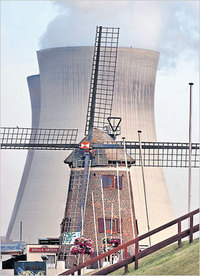 The Belguim windmill looks nice, but the electiricty is produced by the nuclear plant in the background. Source of photo: online version of the NYT article cited below.
The Belguim windmill looks nice, but the electiricty is produced by the nuclear plant in the background. Source of photo: online version of the NYT article cited below.
The latest word on energy, from the 2006 World Economic Forum at Davos, Switzerland:
. . . nuclear energy is suddenly back on the agenda — and not just here. Spurred on by politicians interested in energy independence and scientists who specialize in the field of climate change, Germany is reconsidering a commitment to shut down its nuclear power plants. France, Europe’s leading nuclear power producer, is increasing its investment, as is Finland.
At a time when industrialized countries are wrestling with how to curb carbon dioxide emissions, nuclear energy has one indisputable advantage: unlike coal, oil, natural gas, or even biological fuels, it emits no carbon dioxide. That virtue, in the view of advocates, is enough to offset its well-documented shortcomings.
“It has put nuclear back into the mix,” said Daniel C. Esty, director of the Center for Environmental Law and Policy at Yale University. “We’re seeing a new balancing of the costs and benefits.”
For the full commentary, see:
(Note: ellipsis added.)


Regarding “Nuclear Energy is Suddenly Back on the Agenda” (2007-03-16), there is absolutely no need for nuclear power in the US (and many other parts of the world) because there is a simple mature technology that can deliver huge amounts of clean energy without any of the headaches of nuclear power.
I refer to ‘concentrating solar power’ (CSP), the technique of concentrating sunlight using mirrors to create heat, and then using the heat to raise steam and drive turbines and generators, just like a conventional power station. It is possible to store solar heat in melted salts so that electricity generation may continue through the night or on cloudy days. This technology has been generating electricity successfully in California since 1985 and half a million Californians currently get their electricity from this source. CSP plants are now being planned or built in many parts of the world.
CSP works best in hot deserts and, of course, these are not always nearby! But it is feasible and economic to transmit solar electricity over very long distances using highly-efficient ‘HVDC’ transmission lines. With transmission losses at about 3% per 1000 km, solar electricity may be transmitted to anywhere in the US and Canada too. A recent report from the American Solar Energy Society says that CSP plants in the south western states of the US “could provide nearly 7,000 GW of capacity, or ***about seven times the current total US electric capacity***” (emphasis added).
In the ‘TRANS-CSP’ report commissioned by the German government, it is estimated that CSP electricity, imported from North Africa and the Middle East, could become one of the cheapest sources of electricity in Europe, including the cost of transmission. A large-scale HVDC transmission grid has also been proposed by Airtricity as a means of optimising the use of wind power throughout Europe.
Further information about CSP may be found at http://www.trec-uk.org.uk and http://www.trecers.net . Copies of the TRANS-CSP report may be downloaded from http://www.trec-uk.org.uk/reports.htm . The many problems associated with nuclear power are summarised at http://www.mng.org.uk/green_house/no_nukes.htm .